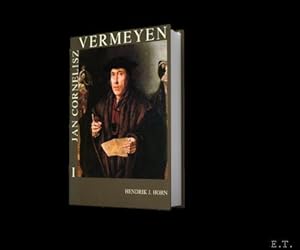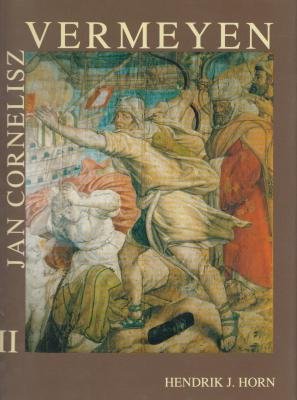HENDRIK J HORN (4 resultados)
Tipo de artículo
- Todo tipo de artículos
- Libros (4)
- Revistas y publicaciones
- Cómics
- Partituras
- Arte, grabados y pósters
- Fotografías
- Mapas
-
Manuscritos y
coleccionismo de papel
Condición
- Todo
- Nuevos
- Antiguos o usados
Encuadernación
- Todo
- Tapa dura (2)
- Tapa blanda
Más atributos
- Primera edición (1)
- Firmado
- Sobrecubierta (1)
- Con imágenes del vendedor (1)
- Sin impresión bajo demanda
Ubicación del vendedor
Valoración de los vendedores
-
The Golden Age revisited. Arnold Houbraken's Great theatre of Netherlandish painters and paintresses. [Title on spine: Arnold Houbraken's Great theatre of Netherlandish painters and paintresses]. [Composed with the assistance of David de Witt].
Librería: Antiquariaat A. Kok & Zn. B.V., Amsterdam, Holanda
Doornspijk, Davaco Publishers, 2000. 2 vols. XXII,985 pp. 185 ills (2 in colour) on [126] plts. Uniform hardcovers d./j. (Davaco Collection). - - New copy !!The Golden Age Revisited examines Houbraken's life, art, and theology before proceeding to the historiography, anecdotes, social and professional thought, art theory, art history, proto-feminism, and overall achievement of his Great Theatre. Hundreds of passages in English translation demonstrate Houbraken's great strengths as a thinker, storyteller, and human being. The book concludes with the reception of his magnum opus in modern scholarship, especially in that of the last two decades. One outcome of the closing chapters is to make Houbraken's Enlightenment thought look very strong in comparison.
-
Jan Cornelisz Vermeyen. Painter of Charles V and his Conquest of Tunis. Paintings - Etchings - Drawings - Cartoons & Tapestries.
Librería: Antiquariaat A. Kok & Zn. B.V., Amsterdam, Holanda
Doornspijk, Davaco Publishers, 1989. 2 vols. 504 pp. 32 col. plts & 340 b./w. ills on 272 plts. Orig. uniform hardcovers (clotbound), d./j. 4to. (Aetas Aurea. Monographs on Dutch & Flemisch Painting, vol. VIII).Vermeyen was one of the leading imperial portraitists of his time, as well as an important painter of religious subjects and a veritable etcher of genius. A monograph on the artist was badly overdue, and the present study seeks in part to fill this need. Whereas Vermeyen was gifted, versatile, and prolific, the experience of the Tunis expedition and of the ensuing Conquest of Tunis series, dominated his career. Vermeyen and Tunis are simply inseparable. Accordingly, Jan Cornelisz Vermeyen, Painter of Tunis combines two monographs, one on the artist and the other on his Tunis series. The text is divided into four parts, each made up of several chapters. Part I, the longest, is the first book-length study of Vermeyen as painter, draftsman, and etcher. It deals with the artist's complete oeuvre, which is richly illustrated. The material includes numerous new findings and presents a detailed and complete chronology for the artist's life and work. As a consequence, Part I is a seminal contribution to the history of northern painting and the graphic arts of the second through fifth decades of the sixteenth century. Part II examines the history Conquest of Tunis series, from the momentous events that occasioned its commission, through the closely documented commission itself, the early copies of the series, and the additional sets woven after it in the course of the sixteenth and eighteenth centuries, to its distinguished career into the present century. The material demonstrates that the fortunes of the series were closely bound to those of the Habsburg dynasty, which, both in Austria and in Spain, continued to venerate Charles V and his Tunisian crusade. The extensive documentation, much of it published here for the first time, will help make the book of great value to the scholar of the tapestry design and production of the sixteenth century. Part III studies how the Conquest of Tunis series depicts the crusade. In the first of his tapestries, Vermeyen stands next to a tablet announcing that he will favour the requirements of accuracy over those of painting. Unprecedentedly close research into the contemporary histories of the Tunis expedition demonstrates that the series indeed presents an exceptionally complete and reliable account of the campaign. As a consequence of Vermeyen's near fanatic devotion to completeness and verisimilitude, as demonstrated by many dozens of details of his cartoons and tapestries that are published here for the first time, the book will be of great interest to military historians of the Reformation Era as well as to anyone interested in reliable images of the military life, costumes, armour, shipping, and Tunisian sites and landscape of the time. Finally, Part IV places the Conquest of Tunis series in the tradition. It examines Vermeyen's models for the compositions of his series as well as for its programme and conception. The Conquest of Tunis is a visual archive, intended as a detailed and lasting record of the deeds and mission of a great emperor.
-
JAN CORNELISZ VERMEYEN. Painter of Charles V and his Conquest of Tunis. Paintings. Etchings. Drawings. Cartoons & Tapestries, 2 volumes
Publicado por Davaco, Aetas Aurea, Vol. VIII, 1989, 1989
Librería: BOOKSELLER - ERIK TONEN BOOKS, Antwerpen, Belgica
Miembro de asociación: ILAB
Cloth bound, 2 vols. in 4to., 504 pp. text, 32 color plates and 340 illustrations on 272 plates in black/white. fine! ISBN 9070288257. In the summer of 1535, the Emperor Charles V led an international crusade to Tunis, he took with him historians and poets as well as a war-artist, Jan Cornelisz Vermeyen (1500-1559). A decade after the Tunis expedition, Vermeyen began his preliminary drawings for a huge tapestry series. The Conquest of Tunis, though little known, is the most important and best documented commission of Charles V as well as the entire Habsburg dynasty. Vermeyen was one of the leading imperial portraitists of his time, as well as an important painter of religious subjects and a veritable etcher of genius. A monograph on the artist was badly overdue, and the present study seeks in part to fill this need. The text is divided into four parts, each made up of several chapters. Part I, the longest, is the first book-length study of Vermeyen as painter, draftsman, and etcher. Part II examines the history Conquest of Tunis series. Part III studies how the Conquest of Tunis series depicts the crusade. Finally, Part IV places the Conquest of Tunis series in the tradition. As new. 777 g.
-
Jan Cornelisz Vermeyen Painter of Charles V and His Conquest of Tunis.Paintings,Etchings,Drawings,Cartoons & Tapestries
Publicado por Davaco Publishers, Doornspîjk, 1989
ISBN 10: 9070288257ISBN 13: 9789070288259
Librería: Luigi De Bei, PREGANZIOL, TV, Italia
Libro Original o primera edición
Couverture rigide. Condición: As New. Estado de la sobrecubierta: As New. prima edizione. larger image Aetas Aurea, VIII JAN CORNELISZ VERMEYEN. Painter of Charles V and his Conquest of Tunis. Paintings. Etchings. Drawings. Cartoons & Tapestries Hendrik J. Horn 1989. 2 vols. in 4to. 504 pp. text, 32 color plates and 340 ills. on 272 plates in black/white. Cloth bound ISBN 90-70288-25-7 In the summer of 1535, the Emperor Charles V (1500-1558) led an international crusade to Tunis to crush the Berber pirate Ottoman admiral Kheir-ed-Din Barbarossa. Charles V took with him historians and poets as well as a war-artist, Jan Cornelisz Vermeyen (1500-1559). A decade after the Tunis expedition, Vermeyen began his preliminary drawings for a huge tapestry series (exceptionally large even by the extravagant standards of contemporary suites) commemorating Charles' crusade. Mary of Hungary, the emperor's sister, acted as his agent in the commission. Between 1546 and 1550, Vermeyen worked on the full size cartoons for the series, ten of which have survived and are now in Vienna. The tapestries, of which ten are now in Madrid, were woven between 1549 and 1554 by Willem Pannemaker, the leading weaver of Brussels. The Conquest of Tunis, though little known, is the most important and best documented commission of Charles V as well as the entire Habsburg dynasty. Jan Cornelisz Vermeyen, Charles V's favourite court artist, is probably better known for the Tunis series. Vermeyen was one of the leading imperial portraitists of his time, as well as an important painter of religious subjects and a veritable etcher of genius. A monograph on the artist was badly overdue, and the present study seeks in part to fill this need. Whereas Vermeyen was gifted, versatile, and prolific, the experience of the Tunis expedition and of the ensuing Conquest of Tunis series, dominated his career. Vermeyen and Tunis are simply inseparable. Accordingly, Jan Cornelisz Vermeyen, Painter of Tunis combines two monographs, one on the artist and the other on his Tunis series. The text is divided into four parts, each made up of several chapters. Part I, the longest, is the first book-length study of Vermeyen as painter, draftsman, and etcher. It deals with the artist's complete oeuvre, which is richly illustrated. The material includes numerous new findings and presents a detailed and complete chronology for the artist's life and work. As a consequence, Part I is a seminal contribution to the history of northern painting and the graphic arts of the second through fifth decades of the sixteenth century. Part II examines the history Conquest of Tunis series, from the momentous events that occasioned its commission, through the closely documented commission itself, the early copies of the series, and the additional sets woven after it in the course of the sixteenth and eighteenth centuries, to its distinguished career into the present century. The material demonstrates that the fortunes of the series were closely bound to those of the Habsburg dynasty, which, both in Austria and in Spain, continued to venerate Charles V and his Tunisian crusade. The extensive documentation, much of it published here for the first time, will help make the book of great value to the scholar of the tapestry design and production of the sixteenth century. Part III studies how the Conquest of Tunis series depicts the crusade. In the first of his tapestries, Vermeyen stands next to a tablet announcing that he will favour the requirements of accuracy over those of painting. Unprecedentedly close research into the contemporary histories of the Tunis expedition demonstrates that the series indeed presents an exceptionally complete and reliable account of the campaign. As a consequence of Vermeyen's near fanatic devotion to completeness and verisimilitude, as demonstrated by many dozens of details of his cartoons and tapestries that are published here for the first time, the book will be of great interest to military historians of the Reformation Era as well as to anyone interested in reliable.




